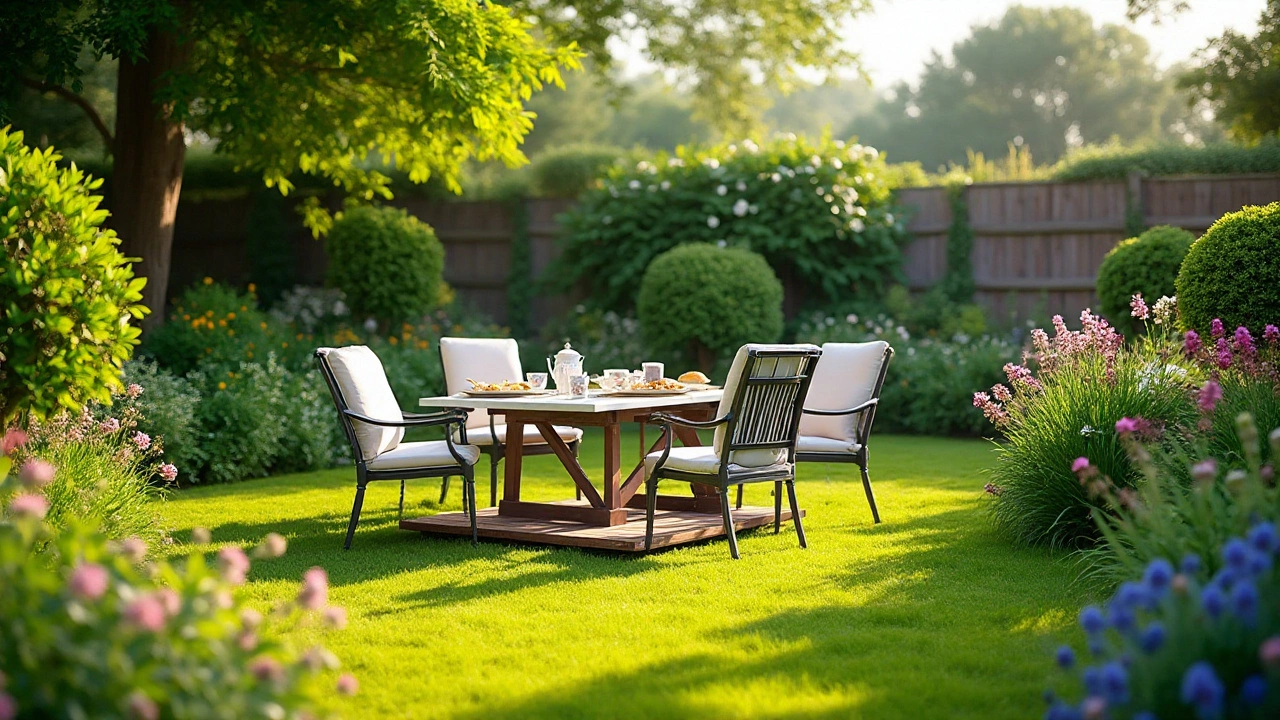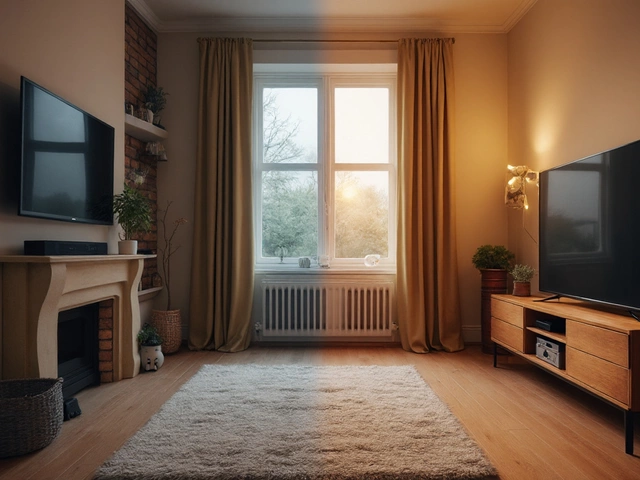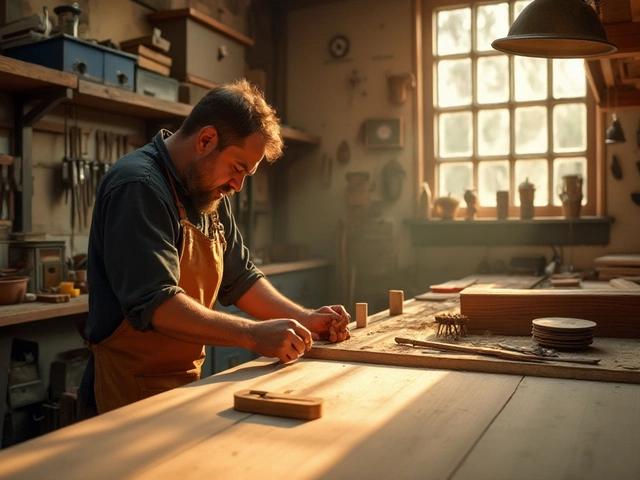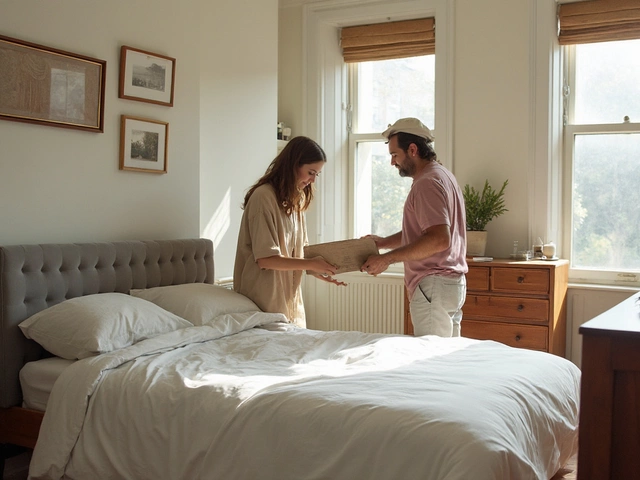Imagine setting up a delightful outdoor space, only to find your beautiful garden furniture sinking into the lush grass the next day. Annoying, right? This happens more often than you might think, but don't worry; it can be fixed.
Grassy areas, while visually appealing and great for relaxation, often pose a challenge for furniture due to their soft and uneven surfaces. Luckily, there are practical measures you can take to ensure your outdoor furniture stays level and secure, enhancing both comfort and aesthetic appeal.
In this guide, we're exploring various strategies that can help mitigate this common issue. From understanding the type of furniture best suited for grass to uncovering clever DIY hacks, this piece offers a wealth of ideas to keep your outdoor setup secure and stylish.
- Understanding Why Furniture Sinks
- Choosing the Right Type of Furniture
- Practical Solutions to Stabilize Furniture
- DIY Projects for Long-Term Stability
- Smart Maintenance Tips
Understanding Why Furniture Sinks
The gentle undulation of a grassy lawn is a picturesque sight, but when hosting outdoor gatherings, it can transform into a perplexing problem. For many homeowners, the sight of garden furniture slowly sinking into the grass is both common and frustrating. This issue primarily stems from the very nature of grass and what lies beneath - soil. Soil composition and its moisture levels are significant players in this game, as their conditions fluctuate with factors such as rain, irrigation, and temperature changes. Waterlogged grass becomes soft and pliable, leading to compression under weight, while dry patches can create uneven terrains. This variability makes maintaining stable garden furniture a persistent challenge.
A deeper dive into soil science reveals that different types of soil react uniquely to pressure and weight. For instance, clay is notorious for retaining water, which not only makes it heavier but also prone to forming a slick, unstable surface once saturated. On the other hand, sandy soil quickly drains, yet lacks the cohesion to support significant weight without shifting. This knowledge is more than academic curiosity; it helps inform which long-term solutions might best keep your outdoor seating level. Recognizing the specific soil type in your garden informs whether drainage upgrades or choosing lighter furniture could solve the problem.
Historical solutions to this problem have been applied in several contexts. Farmers, for example, have long rotated heavy equipment paths to prevent persistent ruts from forming in their fields. This same principle can inform the occasional rearrangement of outdoor seating to avoid creating permanent grooves or indentations.
"Understanding the interaction between grass and garden furniture is akin to understanding the relationship between nature and our designed spaces," notes horticulturist Jane Greenfield, emphasizing the importance of a holistic approach.Moreover, knowing the level of foot traffic in specific areas of your garden also helps determine where heavier furniture might do less damage.
Not to be overlooked is the impact of certain weather conditions. For example, extended periods of rain or the melting of snow in spring can leave the ground exceptionally soft, while drought produces tundra-like firmness. Homeowners unwittingly exacerbate their plight by forgetting to account for these natural changes, potentially allowing their furniture to bear weight on a foundation unprepared for the load. Acknowledging these factors is instrumental in planning effective prevention techniques, whether that means installing temporary pavers for rainy seasons or selecting specific dimensions and weight limits for garden furniture.
Choosing the Right Type of Furniture
When selecting garden furniture for your lawn, understanding the impact of your choice on stability and aesthetics is crucial. Soft soil and grass can transform the most perfectly arranged seating into a wobbly mess, but making the right choice initially can save plenty of hassle. One thing to consider is the weight of the furniture. Heavier pieces, although sturdy, tend to sink more into the ground if the soil is damp or the grass is particularly lush. Lightweight furniture, such as those made from aluminum or wicker, can offer a more stable footprint, especially if you plan to move them frequently around your outdoor seating area.
Another key aspect is the design of the furniture legs. Opting for furniture with wider, flatter legs can distribute weight more evenly, reducing the pressure that might push the legs into the grass. In contrast, narrow legs often act like stakes, piercing easily into soft ground. Some clever designs incorporate adjustable feet, allowing you to manage height discrepancies or tilt, which are useful for uneven surfaces. To address these concerns, look for furniture that boasts a broader base or includes leveling features, which not only enhance stability but also add to visual appeal.
The materials used in the make-up of your outdoor seating also play a vital role in both durability and comfort. While wood naturally complements the garden environment with its organic feel, it’s susceptible to moisture, which can lead to swelling and imbalance, especially on wet grass. Metals require attention to rust, and plastics, though moisture-resistant, need to be robust to withstand weight without bowing. Each material has its strengths, and understanding these can guide your choice based on your specific environmental conditions and the frequency of use.
Considerations for Use and Environment
Beyond the basic materials and design factors, it's wise to think about how you will be using this furniture on the lawn. If it's for regular dining or lounging and will undergo daily use, durability becomes as important as stability. Those hosting frequent garden gatherings might favor stackable or foldable options, which are easier to store and reposition. Additionally, consider choosing styles that integrate well with specific seasonal changes in your area. For instance, areas with high precipitation might benefit from moisture-resistant frames and quick-dry cushion fabrics.
According to a 2023 survey by the Outdoor Furniture Association, "Consumers are increasingly prioritizing function and form over size, with 65% reporting a change in purchasing decisions towards furniture that offers better stability and weather adaptability."
In effect, the market has seen an interesting shift, with manufacturers focusing more on innovative solutions that reconcile look with practicality. This not only highlights the importance of doing your homework before buying but also shows the evolving trends in consumer preferences. Ultimately, selecting the right garden furniture is about marrying your aesthetic desires with pragmatic choices that enhance longevity and usability on your precious lawn.

Practical Solutions to Stabilize Furniture
When it comes to keeping your garden furniture stable and secure on lush grass, it's essential to explore a variety of practical solutions designed for resilience and ease of use. The classic wobbly chair or table can turn an otherwise perfect garden party into a balancing act, but with a bit of knowledge and creativity, your outdoor seating woes can be put to rest. One common and effective strategy is to use furniture pads specifically designed for outdoor use. These are available in various materials, such as rubber or plastic, which provide added friction and prevent the legs of your furniture from sinking. To complement this, you might consider investing in furniture with wider legs or bases, as they distribute weight more evenly across the surface and thus minimize sinkage.
Creating a stable foundation is another approach favored by many homeowners and landscapers alike. Consider laying down a hard surface beneath your furniture, such as a patio or a deck, which not only offers stability but also can be an extension of your home into nature. An unconventional yet effective method is to use paving slabs or gravel beneath key areas where furniture typically sits. This solution not only prevents sinking but also allows for easy rearrangement and adds a textural element to your garden design.
For larger gatherings or events where you need temporary solutions, special outdoor rugs or carpets can be extremely beneficial. They act as a barrier between the soft ground and the furniture while also enhancing the aesthetic appeal of your setting. These rugs, particularly those made of durable, weather-resistant materials, evenly distribute the weight of the furniture, greatly reducing the risk of sinking.
Moreover, experimenting with DIY approaches can lead to personalized solutions while offering a unique charm to the garden. For instance, one can build customized bases for each furniture piece using pressure-treated wood, which can double as an extra feature in your garden landscape. Alternatively, assembling prefabricated tiles in a creative pattern under furniture can both stabilize and elevate your outdoor seating arrangement.
In all these cases, regular maintenance is pivotal. Frequently checking your lawn's firmness and ensuring that no excessive moisture is present are crucial steps. During rainy seasons, using temporary measures like plastic or wooden planks can help distribute weight and maintain balance. As Louise Simpson, an award-winning landscape architect, aptly put it in a
recent interview, "A stable garden is like a canvas; its beauty lies not only in what you can see but also in the unseen care that supports its standing."By integrating these practical solutions, not only will your furniture cease to be a sinking nuisance, but it will also enhance the garden's overall functionality and aesthetic.
DIY Projects for Long-Term Stability
Creating a lasting solution to prevent your garden furniture from sinking into the grass doesn't necessarily require professional intervention. With a bit of ingenuity and some basic materials, you can craft a stable base that both supports your furniture and maintains the aesthetic appeal of your garden. The secret lies in spreading the weight evenly across the lawn, which prevents any single area from becoming too compressed. Begin by considering how platforms or slabs can serve not only as a base but as an enhancement to your outdoor décor.
A popular method involves installing paver stones or tiles beneath each piece of furniture. Choose stones that complement your outdoor space, and arrange them in a pattern that covers a broad area. This effectively spreads the weight of even the heaviest pieces of outdoor seating, offering both stability and a touch of elegance. Installation is straightforward; start by removing a layer of grass slightly larger than each paver, dig into the soil to ensure it’s level, then place the stones snugly together. Secure them tightly, ensuring there's no wobble, promoting a level surface that integrates smoothly with the rest of your lawn.
An alternative approach is to construct a floating deck. This involves laying out a framework of wooden pallets or beams that sit just above ground level. By covering this frame with sturdy wooden planks, you create a solid platform where garden furniture can rest comfortably. Installing a weed barrier beneath the deck is highly recommended, as it helps prevent unsightly growth while keeping maintenance simple. If you're interested in naturalistic design, consider using untreated wood, which can develop a charming weathered look over time. For added durability, seal the wood to protect it from moisture and insects, ensuring longevity.
For those who prefer temporary solutions, consider crafting furniture stakes. Made from heavy-duty materials, such as metal or treated wood, these stakes secure your chairs and tables into the ground. Position stakes at strategic points around the furniture legs and fasten them securely. While not a permanent fix, this method keeps furniture stable during events or gatherings, when seating arrangements may frequently change.
Engaging in DIY projects such as these not only promises a practical outcome but also deepens your connection with your living space. As outdoor design expert, James Ideas, once said,
"The best gardens are those crafted with personal touches, where every piece tells a story."So whether it's through creating a beautiful patio with pavers or a rustic wooden deck, your efforts will not only serve a functional purpose but also enhance the personal narrative of your green retreat.
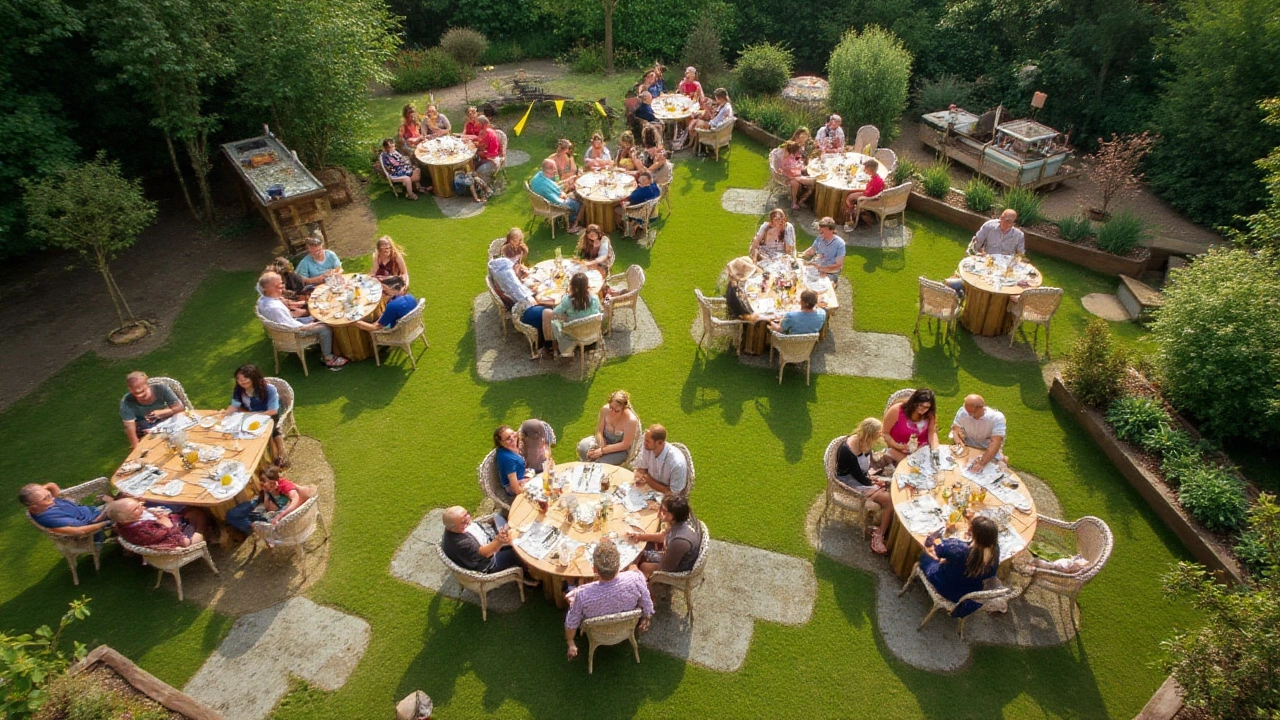
Smart Maintenance Tips
Maintaining your garden furniture to prevent it from sinking into the grass involves more than just occasional rearrangement. Proper maintenance ensures not only the stability of your outdoor seating but also its longevity and overall beauty. Begin by regularly checking the legs of your furniture. Grass, especially when wet, can accelerate wear and tear on the furniture legs, leading to instability. Inspect them for signs of damage or rust, and address any issues promptly, such as by sanding down rusty areas and applying a fresh coat of weather-resistant paint or sealant. This simple task not only enhances aesthetics but adds a protective layer against moisture that can weaken your furniture's foundation.
Another critical aspect is keeping the grass itself in top condition. Healthy grass offers better support compared to patches that are thin or have bald spots. Regular mowing and proper watering create a uniform surface, reducing the likelihood of your furniture tilting or sinking. When mowing, try to keep the grass height consistent, avoiding it being too short as it might lead to soil compaction, which impacts drainage and can create muddy spots. Fertilizing your lawn with appropriate nutrients fosters thicker, healthier grass, acting as a natural cushion for your furniture.
Cleaning your outdoor pieces and the surrounding area is often underrated but impactful. Debris such as fallen leaves or twigs can create uneven surfaces and trap moisture, increasing the risk of corrosion and mold. Use a broom or leaf blower to clear such items regularly, and give your furniture a gentle wash to remove dirt, pollen, or sap, which can degrade materials over time.
For those living in areas with heavy rainfall or significant seasonal changes, considering garden furniture covers is a wise move. While they are sometimes deemed an optional purchase, their ability to protect from harsh environmental elements can greatly extend the life of your furniture. Opt for covers made of durable, weather-resistant materials that fit snugly to prevent water pooling. As noted by The Royal Horticultural Society, “A little time invested now will see your garden in perfect order next season.” These relatively simple steps help in maintaining the value of your investment and keeping your outdoor setup inviting and cozy year-round.
Finally, for owners of heavier pieces, re-assessing the weight distribution can alleviate some pressure points on the grass. Adjustable feet or sliders can add extra stability and prevent sinking. Adding a layer of firm supports such as planks or grill mats under each leg provides a broader base which spreads the weight more evenly. While some might see these steps as excessive, they save time in the long run and preserve the quality of your beloved garden space.
